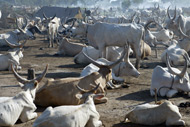Surprise!

According to a new report published by the United Nations Food and Agriculture Organization, the livestock sector generates more greenhouse gas emissions as measured in CO2 equivalent – 18 percent – than transport. It is also a major source of land and water degradation.
Says Henning Steinfeld, Chief of FAO’s Livestock Information and Policy Branch and senior author of the report: “Livestock are one of the most significant contributors to today’s most serious environmental problems. Urgent action is required to remedy the situation.”
With increased prosperity, people are consuming more meat and dairy products every year. Global meat production is projected to more than double from 229 million tonnes in 1999/2001 to 465 million tonnes in 2050, while milk output is set to climb from 580 to 1043 million tonnes.
Long shadow
The global livestock sector is growing faster than any other agricultural sub-sector. It provides livelihoods to about 1.3 billion people and contributes about 40 percent to global agricultural output. For many poor farmers in developing countries livestock are also a source of renewable energy for draft and an essential source of organic fertilizer for their crops.
But such rapid growth exacts a steep environmental price, according to the FAO report, Livestock’s Long Shadow –Environmental Issues and Options. “The environmental costs per unit of livestock production must be cut by one half, just to avoid the level of damage worsening beyond its present level,” it warns.
When emissions from land use and land use change are included, the livestock sector accounts for 9 percent of CO2 deriving from human-related activities, but produces a much larger share of even more harmful greenhouse gases. It generates 65 percent of human-related nitrous oxide, which has 296 times the Global Warming Potential (GWP) of CO2. Most of this comes from manure.
And it accounts for respectively 37 percent of all human-induced methane (23 times as warming as CO2), which is largely produced by the digestive system of ruminants, and 64 percent of ammonia, which contributes significantly to acid rain.
Livestock now use 30 percent of the earth’s entire land surface, mostly permanent pasture but also including 33 percent of the global arable land used to producing feed for livestock, the report notes. As forests are cleared to create new pastures, it is a major driver of deforestation, especially in Latin America where, for example, some 70 percent of former forests in the Amazon have been turned over to grazing.
Land and water
At the same time herds cause wide-scale land degradation, with about 20 percent of pastures considered as degraded through overgrazing, compaction and erosion. This figure is even higher in the drylands where inappropriate policies and inadequate livestock management contribute to advancing desertification.
The livestock business is among the most damaging sectors to the earth’s increasingly scarce water resources, contributing among other things to water pollution, euthropication and the degeneration of coral reefs. The major polluting agents are animal wastes, antibiotics and hormones, chemicals from tanneries, fertilizers and the pesticides used to spray feed crops. Widespread overgrazing disturbs water cycles, reducing replenishment of above and below ground water resources. Significant amounts of water are withdrawn for the production of feed.
Livestock are estimated to be the main inland source of phosphorous and nitrogen contamination of the South China Sea, contributing to biodiversity loss in marine ecosystems.
Meat and dairy animals now account for about 20 percent of all terrestrial animal biomass. Livestock’s presence in vast tracts of land and its demand for feed crops also contribute to biodiversity loss; 15 out of 24 important ecosystem services are assessed as in decline, with livestock identified as a culprit.
Remedies
The report, which was produced with the support of the multi-institutional Livestock, Environment and Development (LEAD) Initiative, proposes explicitly to consider these environmental costs and suggests a number of ways of remedying the situation, including:
Land degradation – controlling access and removing obstacles to mobility on common pastures. Use of soil conservation methods and silvopastoralism, together with controlled livestock exclusion from sensitive areas; payment schemes for environmental services in livestock-based land use to help reduce and reverse land degradation.
Atmosphere and climate – increasing the efficiency of livestock production and feed crop agriculture. Improving animals’ diets to reduce enteric fermentation and consequent methane emissions, and setting up biogas plant initiatives to recycle manure.
Water – improving the efficiency of irrigation systems. Introducing full-cost pricing for water together with taxes to discourage large-scale livestock concentration close to cities.
These and related questions are the focus of discussions between FAO and its partners meeting to chart the way forward for livestock production at global consultations in Bangkok this week. These discussions also include the substantial public health risks related to the rapid livestock sector growth as, increasingly, animal diseases also affect humans; rapid livestock sector growth can also lead to the exclusion of smallholders from growing markets.



 Per E-Mail an einen Freund senden
Per E-Mail an einen Freund senden Quellcode kopieren
Quellcode kopieren  Drucken
Drucken













 suprememastertv.com
suprememastertv.com